- Fogo is a Layer 1 blockchain designed specifically for institutional-grade finance, aiming to seamlessly bridge traditional finance with the decentralized world.
Written by: Deep Tide TechFlow
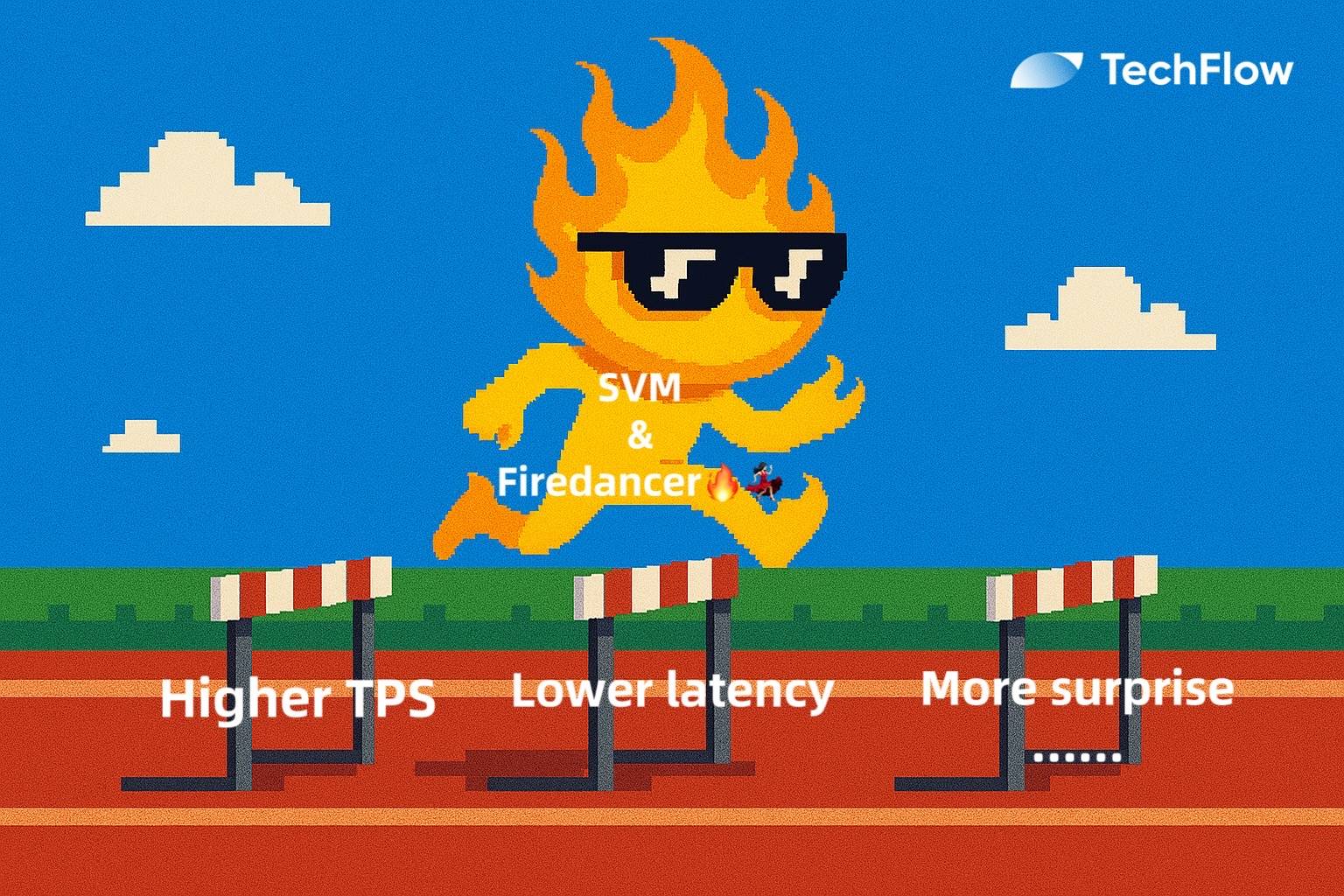
Introduction
The crypto market is always a battlefield driven by attention, and projects in new trends often hide the biggest opportunities.
At the beginning of this year, the most obvious trend is the accelerated entry of institutional investors and "Made in America":
By early 2025, institutions are expected to hold about 15% of the Bitcoin supply, nearly half of hedge funds have begun allocating digital assets, and the push for presidential legislation, the launch of Bitcoin ETFs in the U.S., and the surge of RWA (real-world assets) on-chain have further fueled this trend.
As "institutional-grade on-chain finance" gradually becomes a necessity, both from a narrative and product perspective, there is a need for support that combines traditional financial performance with decentralized infrastructure.
In this context, suitable new infrastructure projects have become a new engine for seeking Alpha.
Recently, a project called Fogo has caught our attention; from the publicly available information, it seems to meet all the above conditions.
A TL;DR version is:
Fogo is a Layer 1 blockchain designed for institutional-grade finance, aiming to seamlessly bridge traditional finance with the decentralized world.
Technical Highlights: Utilizing Firedancer developed by Jump Trading as the sole client, achieving faster TPS and block times. Supported by the Solana Virtual Machine (SVM), compatible with Solana application migration.
Team Strength: Led by former quantitative analysts from traditional financial institutions and early developers of Solana, backed by Douro Labs and Jump Crypto, rooted in the U.S., aligning with this year's "Made in America" narrative.
Funding Background: Seed round financing of $5.5 million, recently raised $8 million on Cobie's financing platform Echo at a $100 million token valuation.
Participation Opportunity: Currently launched the Flames Program, where users can earn points through various interactions, seizing the opportunity for future airdrops, providing a stable entry window in the current volatile market.
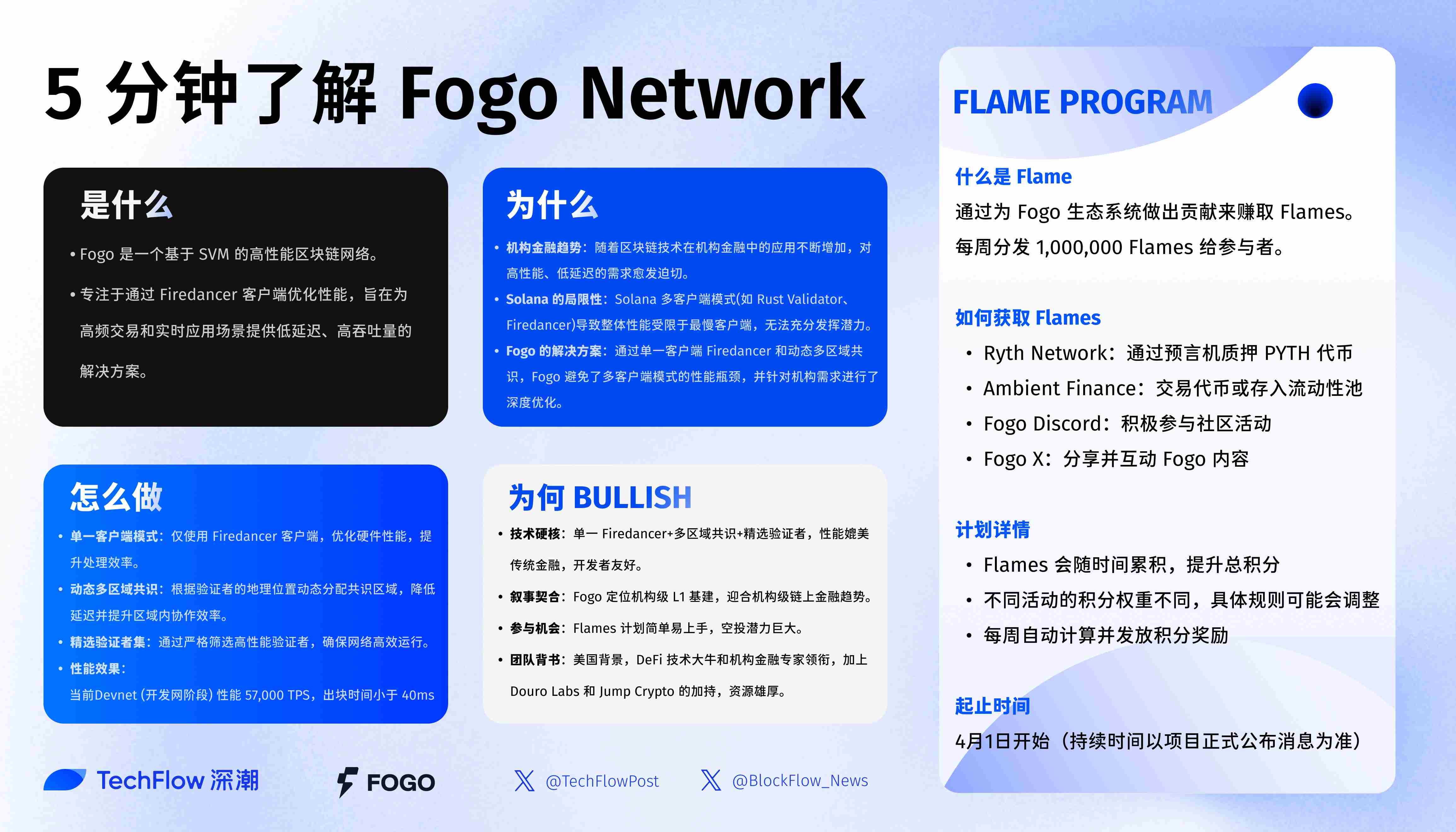
In summary, for readers who are not technically savvy, you just need to know that Fogo is a new L1 with better performance and rich resources and endorsements.
More importantly, it is the Flames Program mentioned above, as this is the focus of everyone's attention.
Therefore, this article will first provide a complete guide and introduction on how to participate in Fogo's Flames Program, followed by a deeper analysis of the Fogo blockchain.
Complete Guide and Introduction to the Flames Program
Previously, Fogo's official Twitter has been conducting a countdown to warm up, indicating that the project team has made ample marketing preparations for this event.
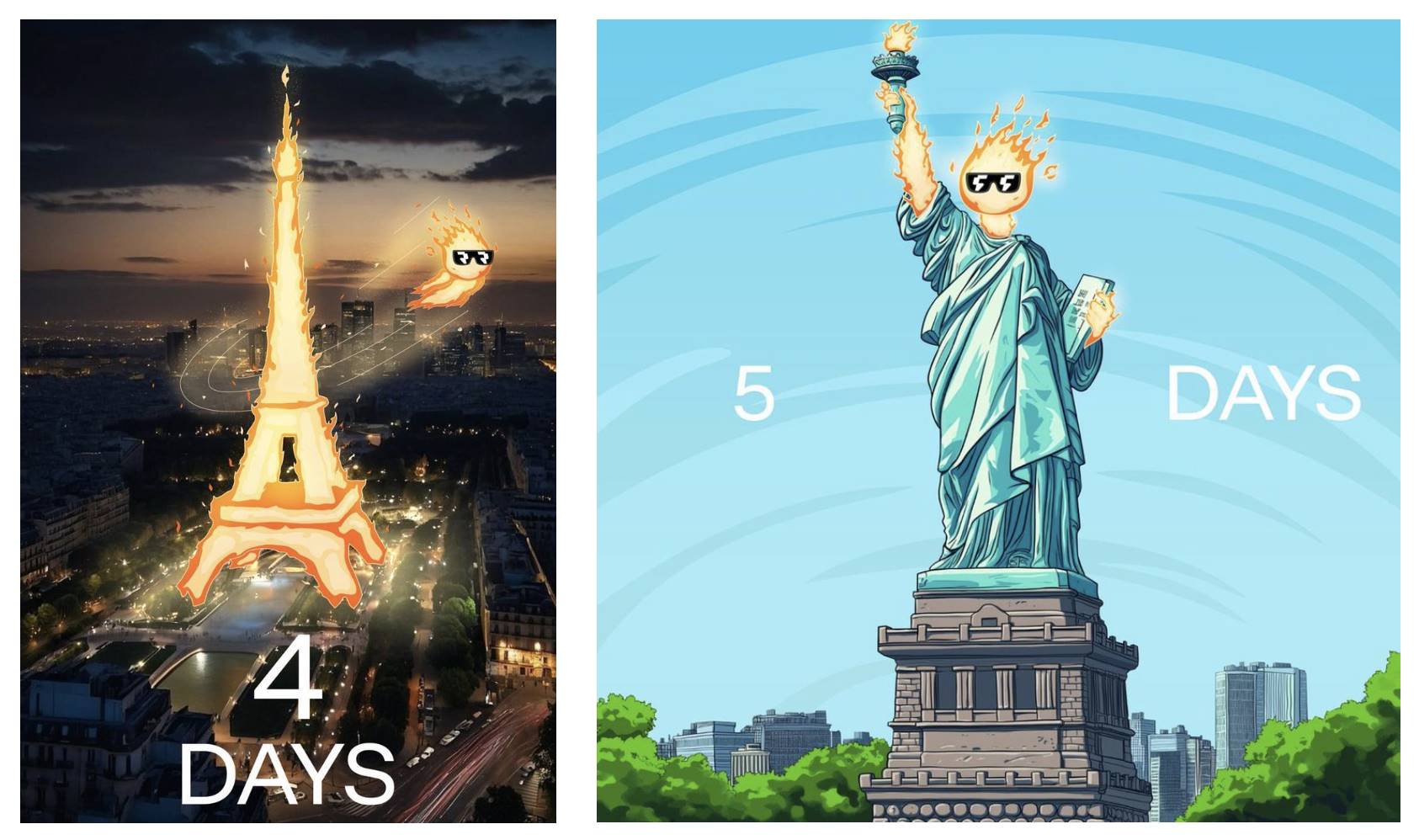
What is the Flames Program?
The Flames Program is an ecological incentive plan launched by Fogo, aimed at promoting the early development of the Fogo ecosystem by rewarding users for their active participation.
From the name, "Flames" is a continuation of the Firedancer client naming, symbolizing vitality and dynamism within the ecosystem. According to official information, Flames is a form of points that may be exchanged for Fogo tokens or other ecological rewards in the future.
Every week, Fogo will distribute 1,000,000 Flames to participants, rewarding those who contribute to the ecosystem. These contributions include interactions with ecosystem partner projects and activity on official social channels.
Why Participate in the Flames Program?
Early User Benefits: As an early activity launched by Fogo, the Flames Program provides users with a low-threshold opportunity to participate and accumulate ecological points. History shows that early participants in similar activities often receive excess returns, such as airdrops and priority rights.
Future Potential: Although Fogo's token has not yet been announced, it is foreseeable that Flames, as ecological points, will likely increase in value as the ecosystem develops. Participating in the activity not only seizes the opportunity for future token airdrops but also allows deep involvement in the construction of the Fogo ecosystem.
Diverse Participation Methods: Whether you are a DeFi user, an active social media participant, or a blockchain novice, you can find suitable ways to participate.
How to Participate in the Flames Program?
According to official materials, the main ways to participate in the Flames Program are divided into two categories: interactions with ecosystem partner projects and active behavior on official social media.
- Interactions with Ecosystem Partner Projects
- Pyth Network: Stake PYTH tokens
By staking PYTH tokens through the oracle (Oracle Integrity Staking, abbreviated as OIS). Users can participate in staking on Pyth's official staking page (link).
It is important to note that Pyth currently offers two staking methods.
For first-time participants, when entering the staking page, be sure to select the OIS (Oracle Integrity Staking) mode, rather than the Pyth Governance mode, to avoid staking tokens that do not meet the activity eligibility.
Additionally, if you have previously staked tokens in the Pyth Governance mode, you can directly participate in OIS without needing to unlock or restake; similarly, if your tokens were staked in Governance mode before OIS was launched, you can also directly participate in OIS without withdrawing the tokens.

- Ambient Finance: Trade or provide liquidity
Ambient (formerly CrocSwap) is a decentralized trading protocol that allows for the combination of concentrated and constant product liquidity on any pair of blockchain assets.
Its founder Doug is also a co-founder of Fogo, so participating in this project to earn Fogo points is quite reasonable.
In practice, you can trade tokens on the Ambient Finance platform or deposit tokens into liquidity pools (LP Vaults). These interactions not only help you earn Flames but also familiarize you with DeFi-related partner projects within the Fogo ecosystem.
- Active Behavior on Official Social Media
Fogo Discord: Stay active in Fogo's Discord community; having a role can earn you Flames points.
Fogo Twitter: By sharing, commenting, liking Fogo's tweets, or retweeting content related to Fogo, you can also earn points.
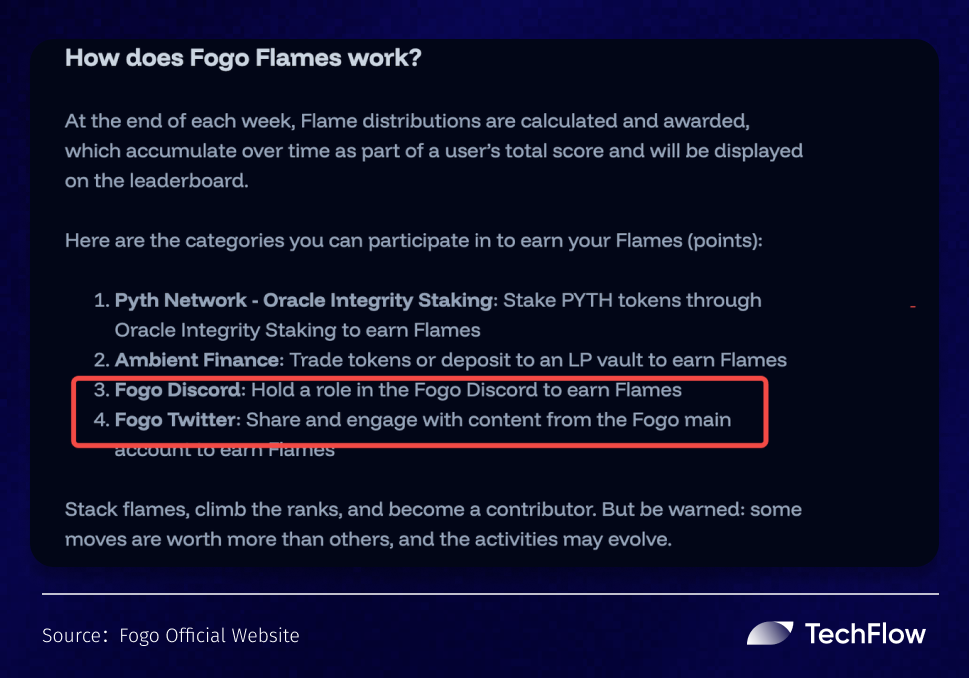
Rules and Details of Flames
Point Accumulation: Flames will accumulate over time, forming your total points. Rewards are calculated and automatically distributed weekly based on user contributions.
Point Weighting: Different activities have different point values; for example, staking PYTH tokens may yield more points than simple social media interactions.
Dynamic Adjustment of Activities: The official may adjust activity rules based on ecosystem development, such as adding or optimizing participation methods.
Leaderboard Tracking: Users can check their points ranking through the official leaderboard, as shown in the image below.

Utilizing Solana's Firedancer, Driving a Ferrari on a New Highway
If, in addition to participating in activities, you are also interested in Fogo's technology and products, here is a simplified explanation we summarized after researching Fogo to help you quickly understand it.
1. How can I quickly understand Fogo?
Fogo's official definition is: "Fogo is an SVM chain running the Firedancer client, aimed at achieving large-scale real-time experiences."
This statement seems simple, but it hides a huge ambition for blockchain performance optimization.
To understand the true significance of Fogo, we need to clarify two key technical concepts—SVM and Firedancer.
We will try to make the technical concepts more accessible; for most readers, understanding the effects that the technology can achieve is more important.
- Key Concept 1: SVM
Solana Virtual Machine is the core operating environment of the Solana network, which can be understood as its "operating system." All smart contracts and applications running on Solana are executed through the SVM.
Key point: Fogo's choice to be based on SVM means it inherits Solana's technical ecosystem, allowing developers to seamlessly migrate existing applications to Fogo.
- Key Concept 2: Firedancer
Firedancer is a high-performance client developed by Jump Crypto specifically for Solana. Its goal is to make the Solana network run faster and more stably.
You may have heard of the Firedancer upgrade for Solana; in fact, by lowering the hardware requirements for validators, Firedancer makes it easier to run nodes.
The increase in speed, reduction in costs, and higher resilience make it a key factor in solving Solana's scalability issues. Firedancer's mission is to bring the performance of the Solana network closer to that of traditional financial systems, such as NASDAQ, which processes 100,000 transactions per second.
However, as of now, the Firedancer upgrade has not been fully implemented on Solana.
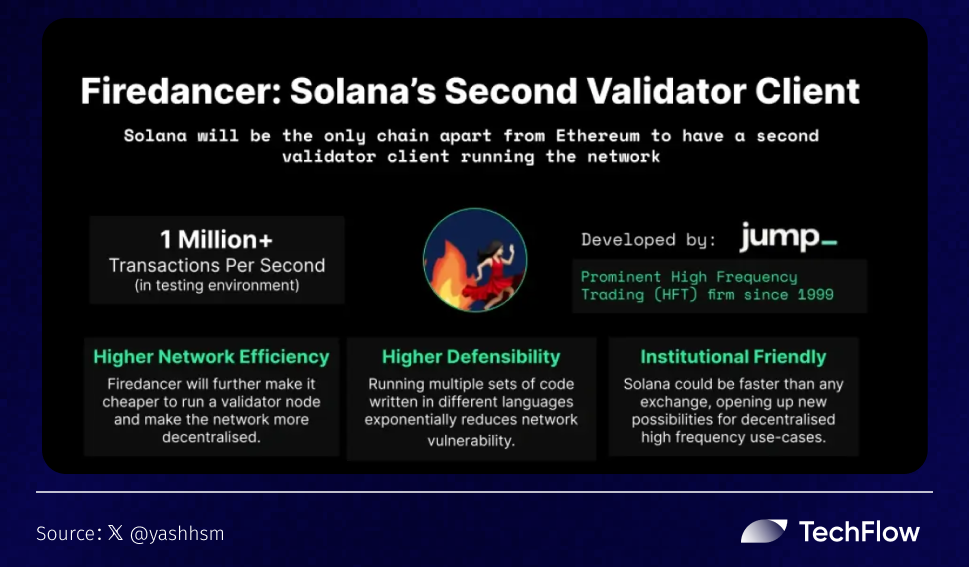
2. Okay, but why create a new L1?
Since Solana has the Firedancer upgrade, which is expected to make it faster and better once implemented, why do we need to create Fogo?
However, the problem still exists: even if Firedancer is faster, it cannot change one reality—Solana's multi-client model means that network speed is limited by the slowest node, and not all validators can immediately switch to Firedancer.
As Fogo co-founder Doug Colkitt said: “It's like having a Ferrari, but you're driving it in congested traffic in New York City.”
Firedancer is like a Ferrari, but other factors on Solana are causing congestion.
Thus, the solution becomes building a dedicated highway for the Ferrari.
Instead of letting Firedancer be dragged down, it is better to give it a dedicated stage. The birth of Fogo is precisely to maximize the potential of Firedancer; after all, everyone could have just used the same client from the start.
Therefore, as an independent new L1, Fogo is no longer limited by the multi-client model and does not have to worry about whether existing validator nodes will update their clients (since it is created from scratch). Instead, it fully releases the performance of Firedancer through a unified client and innovative design.
Why is a single-client model superior?
When a blockchain network approaches the physical limits of hardware and network performance, differences between implementations of different clients can lead to performance bottlenecks.
Thus, Fogo is a "purebred" Firedancer from the start, without needing a "major overhaul."
3. Agreed, so how does Fogo do it?
- Single Firedancer Client Model
Fogo's primary innovation is choosing Firedancer as the only standard client, completely abandoning the performance bottlenecks that may arise from Solana's multi-client model.
In one sentence, it can be described as:
“Using only the fastest client, keeping the network at peak performance levels.”
If you are not familiar with Firedancer, you just need to have a rough idea of the benefits it brings. First is parallel processing, which allows multiple transactions to be processed simultaneously, significantly increasing throughput; second is memory optimization, enabling the hardware where nodes are located to utilize storage and other resources more efficiently, reducing latency caused by transactions. It is worth mentioning that Firedancer focuses more on hardware improvements, such as directly optimizing the interaction between nodes and physical devices, further compressing transaction processing time.
The following meme effectively illustrates the reduction in latency brought about by performance optimization.

- Dynamic Multi-Region Consensus
Another core innovation of Fogo is the introduction of a multi-region consensus mechanism.
This mechanism dynamically optimizes collaboration based on the geographical location of validators, achieving ultra-low latency consensus while retaining the security features of global consensus.
The official term for this consensus mechanism is "Follow the Sun." Specifically, it means that validation nodes will dynamically adjust based on the active trading hours of global trading zones.
This metaphor implies that when the sun rises, it usually corresponds to a high trading volume period in a certain region, at which point validation activities will concentrate in that area. This mechanism ensures that the allocation of validation resources matches the rhythm of global trading activities, thereby enhancing the overall efficiency of the network.
We can simply describe this consensus principle as follows:
First, validators are assigned to specific "consensus regions" based on their geographical location, where validators collaborate closely to achieve low-latency consensus.
Second, when special situations arise, such as a regional consensus failure, the network will automatically switch to global consensus mode to ensure network stability.
At the same time, considering real-world factors, by rotating regions, it avoids long-term control of the network by any single jurisdiction, enhancing resistance to censorship; it can also mitigate network interruptions caused by natural disasters or data center failures.
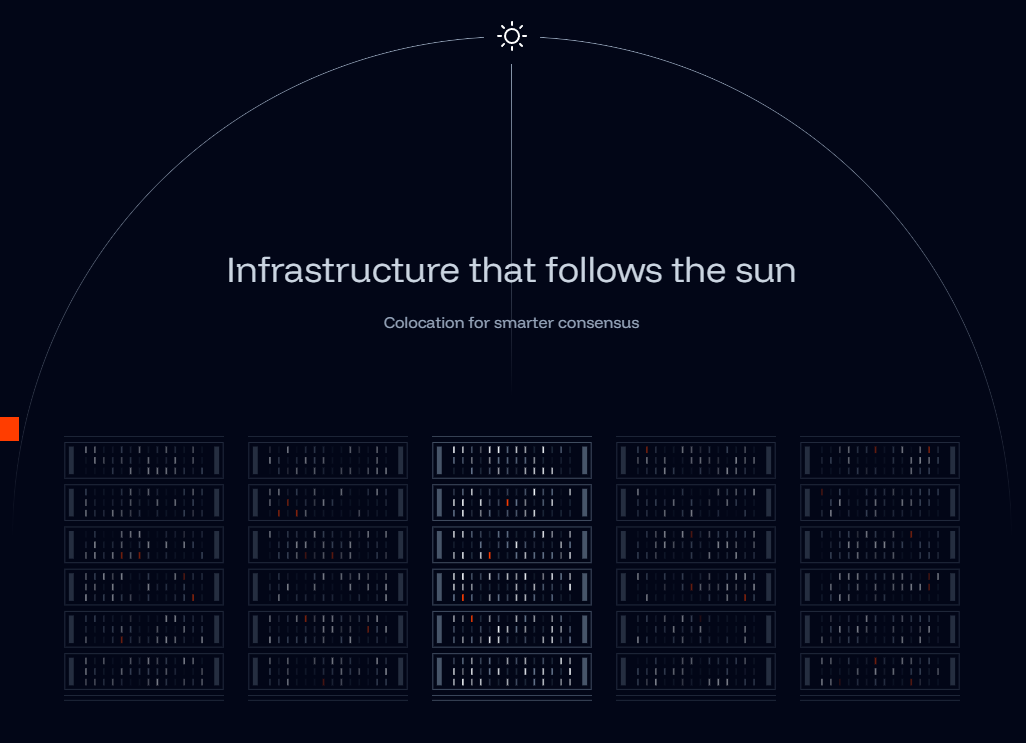
- Selected Validator Set
Finally, in terms of selecting validators, to ensure high performance and stability of the network, Fogo adopts a selected validator set strategy, strictly screening validators and promoting efficient network operation through economic incentives.
So what are the selection criteria?
First is the economic standard; validators need to meet minimum staking requirements to ensure they have sufficient economic "chips."
Second is the hardware standard; validators must also prove that they possess high-performance hardware and network capabilities to support the operational needs of the Fogo network.
In terms of economic incentives, validators will earn higher rewards for using the high-performance client (i.e., Firedancer). The network's dynamic block time and size parameters will create economic pressure on validators, prompting them to choose the fastest client and maintain efficient operation. If validators fail to meet performance requirements, they may face economic penalties or be expelled from the validator set.
The benefit of this design is that it can prevent low-performance nodes from dragging down the overall performance of the network. Through self-optimization of validators, the entire network is driven towards greater efficiency and stability.
Currently, Fogo is in the development network phase and is about to enter the test network stage, which also means that more people can participate in network interactions.
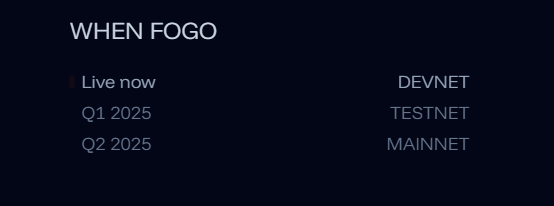
Public data shows that Fogo's development network (Devnet) currently achieves a performance of 57,000 TPS, with block times of less than 40ms; data from the test network and mainnet is yet to be observed further.
Finally, for ease of comparison, we can use a table to illustrate the similarities and differences between Fogo and Solana:
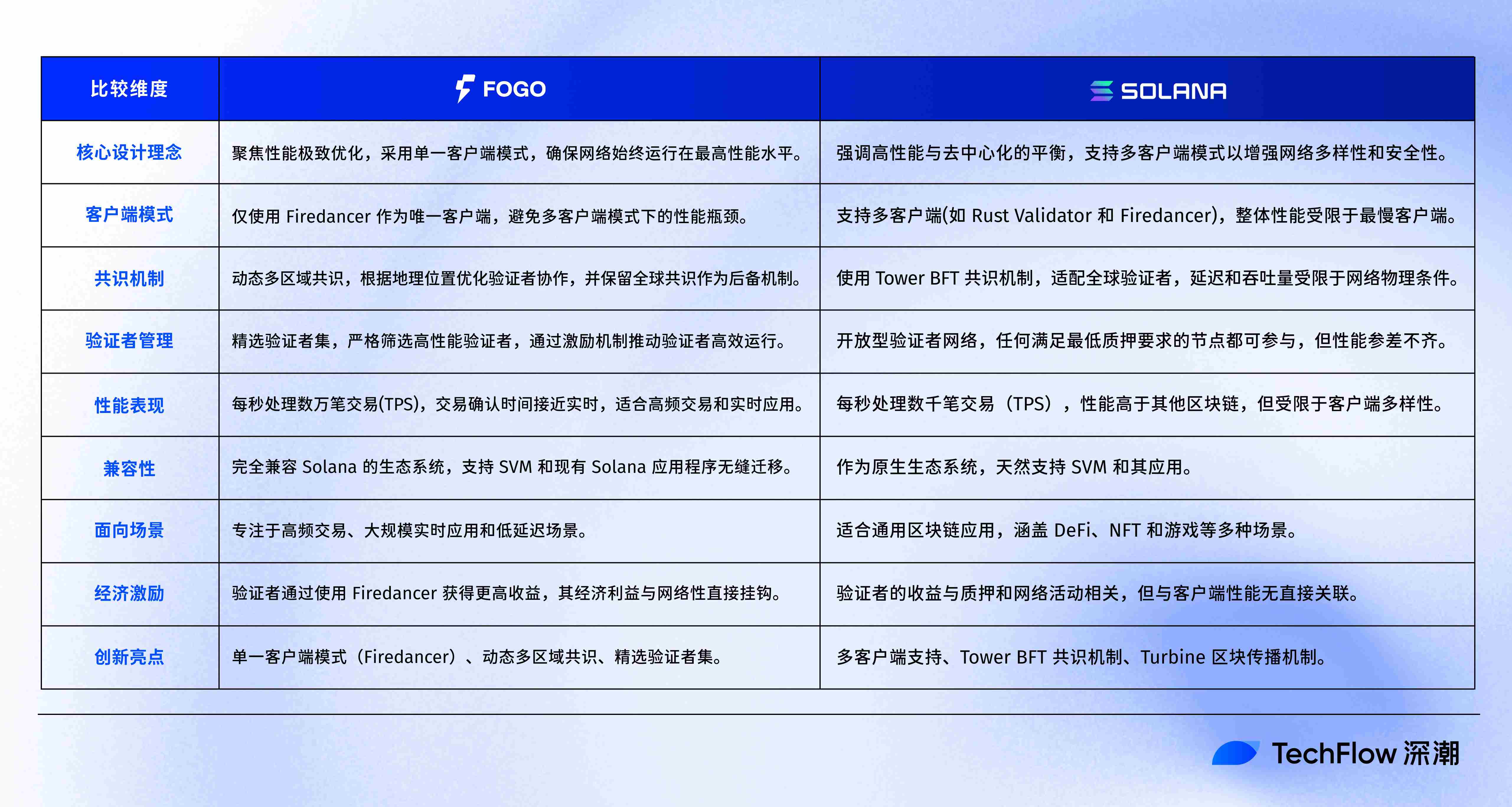
From the Correct Narrative of Institutional Entry to the Right Team Configuration
Clearly, there are many high-performance L1s on the market; why does Fogo have a place in this competition?
From the perspective of ordinary players' interests, do we have more reasons to pay attention to this project?
Perhaps we can delve into three aspects: market trends, the project's own team, and the resources it can connect to, to analyze whether Fogo is worth our deep participation.
1. **Institutional entry has become a new trend this year, but it requires lower *latency* and high-performance infrastructure support**
Institutional-grade blockchains are becoming a key trend for 2025, especially in the U.S. market. The U.S. narrative (such as "King of Understanding" Trump's crypto-friendly policies) and the participation of old money (such as hedge funds allocating digital assets) have driven this wave.
RWA Tokenization (the tokenization of real-world assets) such as real estate and bonds has seen a total market value increase threefold in the past 12 months, indicating institutional interest in on-chain finance.
However, existing blockchain solutions (like Solana) are limited by global consensus mechanisms, resulting in higher transaction delays, making it difficult to meet institutional demands for low-latency environments.
For example, high-frequency trading requires microsecond-level execution speeds, while traditional blockchains typically have block times exceeding several hundred milliseconds.
Fogo aims to achieve faster throughput and lower block delays through the Firedancer client and multi-region consensus mechanism, ultimately approaching the performance levels of traditional financial systems (such as NASDAQ's 100,000 transactions per second).
Given Fogo's positioning as "enabling on-chain institutional-grade finance," it is also suitable for applications such as stablecoins (like USDC) and U.S. Treasury bonds.
2. A team that understands traditional finance better
Trends exist, but the right people must be in place to capitalize on them.
Both co-founders of Fogo have a deep connection to the U.S. market.
Co-founder Douglas is a technical expert in the DeFi field, having developed trading systems at Goldman Sachs and frequently sharing insights on X.
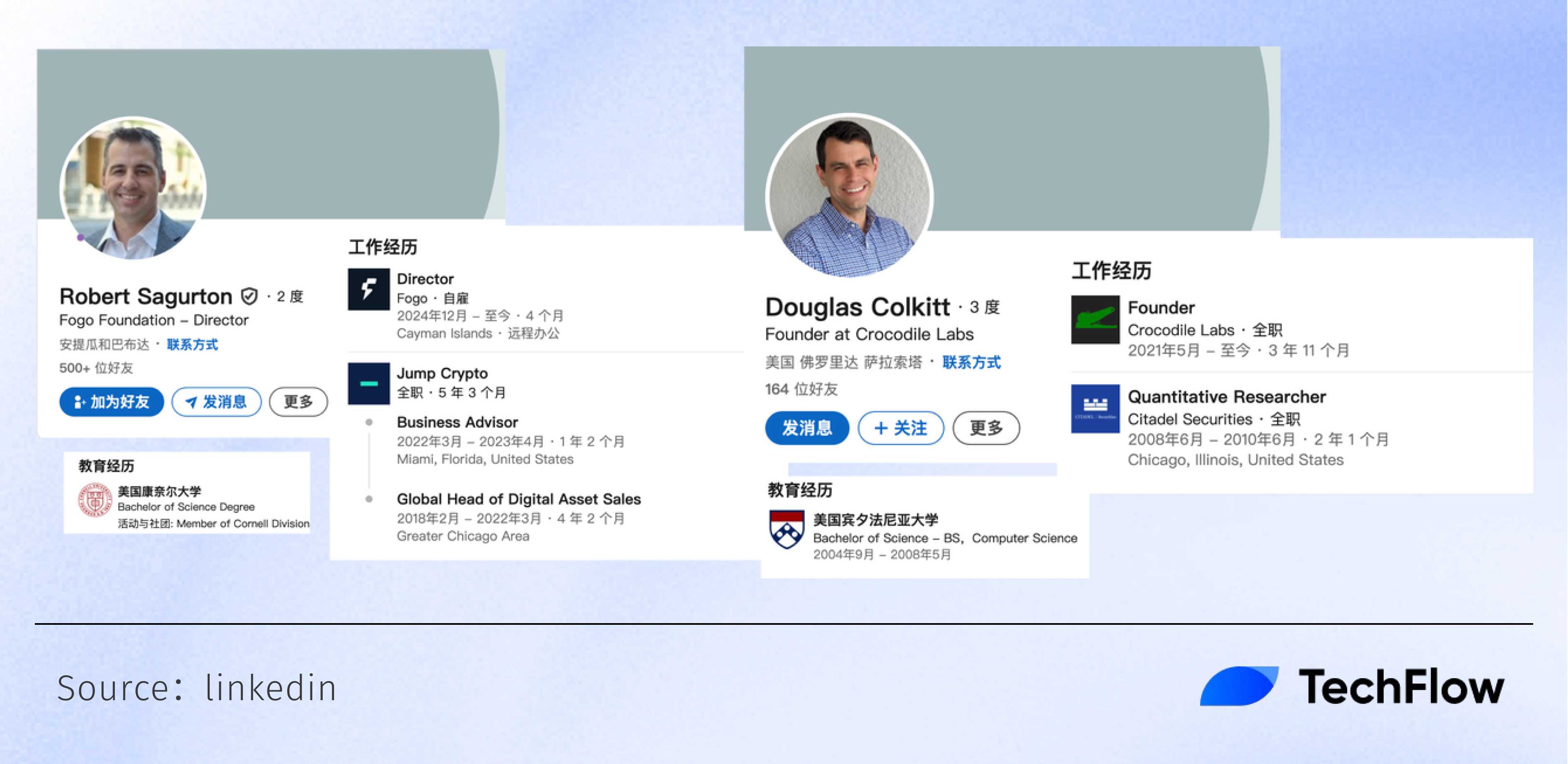
By reviewing past posts, it can be seen that Douglas has a deep understanding of products in the industry, such as DEX and perpetual contracts, and even designed a DEX called ambient himself.
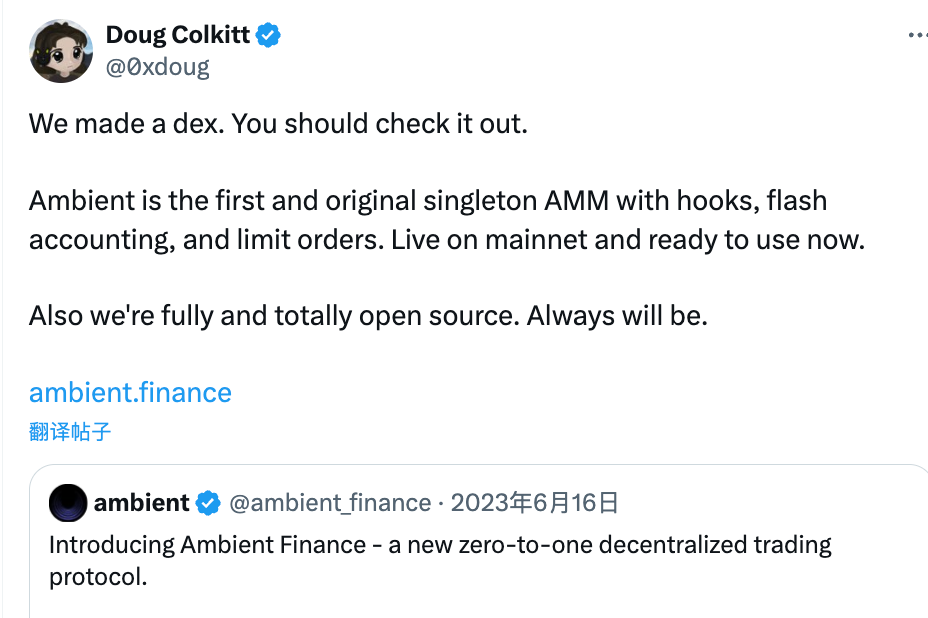
The other co-founder, Robert, previously worked at Jump Crypto and has substantial experience in institutional finance, providing direct insights into the design of the Firedancer client;
Since Fogo is a new L1 based on the Firedancer client, this aspect is completely aligned with expertise, or in other words, it directly channels Jump's design experience into Fogo.
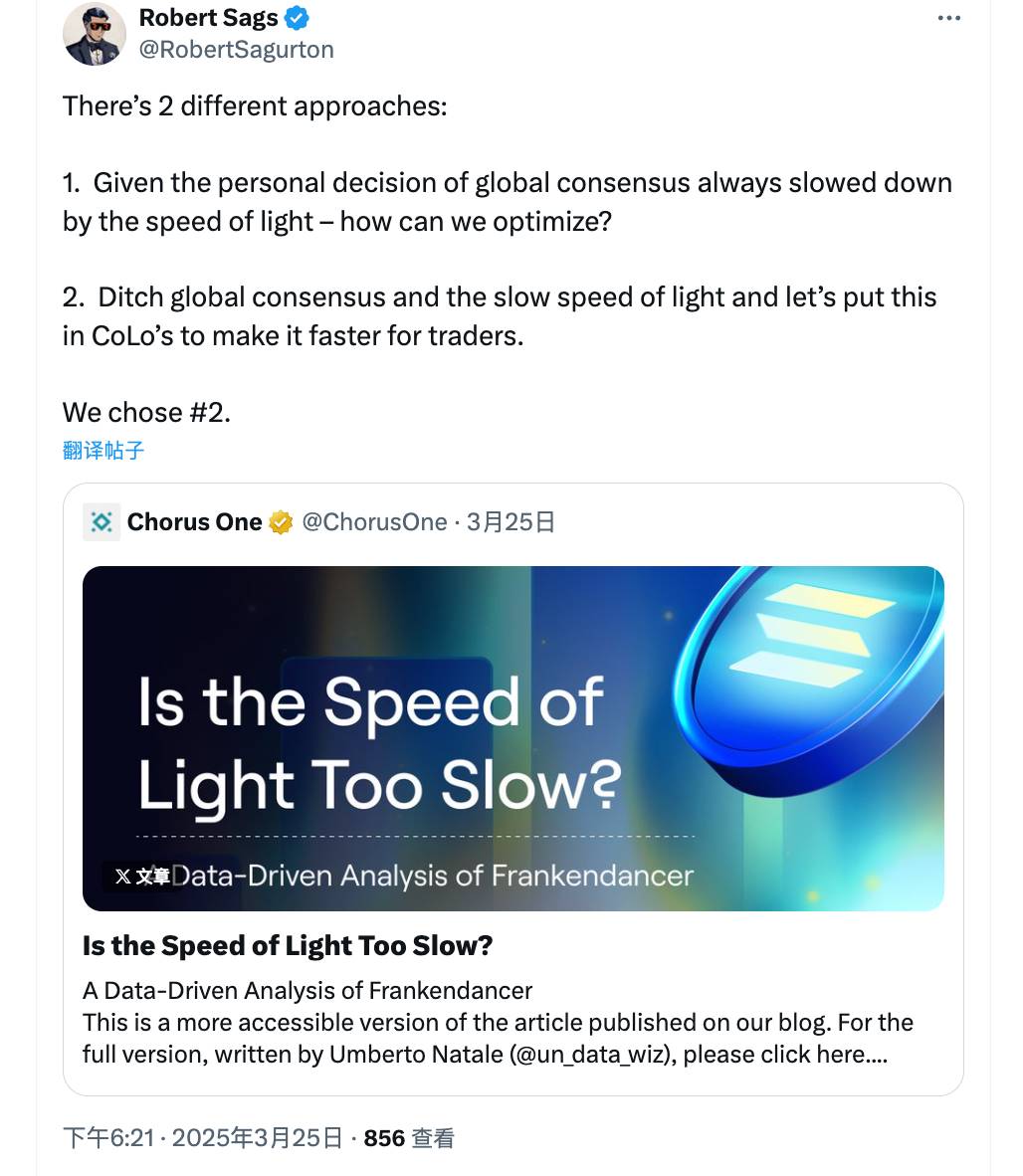
It is worth noting that Fogo is supported by Douro Labs, the team behind the Pyth oracle network, which provides real-time financial data, crucial for DeFi and institutional applications.
Naturally, Pyth is also closely related to Jump Crypto, which is the developer of Fogo's tech stack (Firedancer), providing strong resources and technical backing. This gives Fogo a competitive advantage in both technical and financial domains.
3. Ecosystem Integration and Convenience for Solana Players
Fogo is based on the Solana Virtual Machine (SVM), making it compatible with the Solana ecosystem, allowing developers to seamlessly migrate existing applications and reduce development costs and learning curves. This is a significant convenience for Solana users, as existing SOL assets can quickly flow to Fogo through the Wormhole cross-chain bridge, enhancing liquidity.
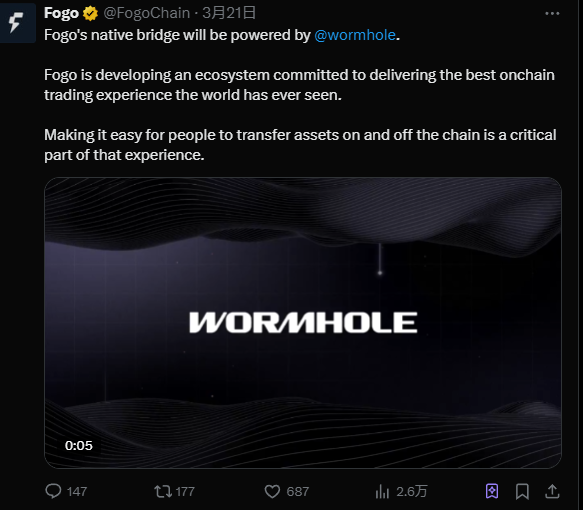
The integration of Pyth ensures that Fogo provides high-quality real-time data, which is crucial for DeFi and RWA applications. Wormhole supports cross-chain interoperability, allowing assets to flow between different chains and attracting more ecosystem participants. For example, users can bridge assets from Solana to Fogo to enjoy its high-performance environment.
4. Funding and Market Confidence
Fogo's funding situation demonstrates investors' recognition of its potential.
According to Rootdata data, Fogo completed an $8 million community round of funding through the Echo platform in January 2025, with a valuation of $100 million. Prior to that, it raised $5.5 million in a seed round led by Distributed Global.
The Echo platform is operated by the well-known overseas KOL Cobie, who has a high profile in the English-speaking community, making it easier to form a collective effect among investors.
Summary
The name Fogo literally means "fire," symbolizing the project's passion, drive, and spirit of innovation, while also forming an intuitive connection with its flame logo.
Overall, Fogo's narrative is not only about technological innovation but also about its vision to create an efficient bridge between traditional finance and crypto, backed by resources and a capable team for execution.
While aligning with the current crypto market's "Made in America" narrative, the label of "fastest L1" is more likely to spark discussion and topics in the precious attention market.
For ordinary users, the Flames Program is an easy way to participate; for developers and institutions, Fogo offers a high-performance and highly compatible development environment.
In the future on-chain financial world, Fogo may become an indispensable part. If you are looking for a project with both technical potential and clear participation opportunities, Fogo is worth your time to understand and engage with.
免责声明:本文章仅代表作者个人观点,不代表本平台的立场和观点。本文章仅供信息分享,不构成对任何人的任何投资建议。用户与作者之间的任何争议,与本平台无关。如网页中刊载的文章或图片涉及侵权,请提供相关的权利证明和身份证明发送邮件到support@aicoin.com,本平台相关工作人员将会进行核查。




